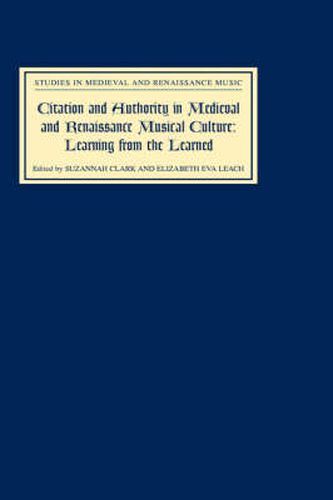Readings Newsletter
Become a Readings Member to make your shopping experience even easier.
Sign in or sign up for free!
You’re not far away from qualifying for FREE standard shipping within Australia
You’ve qualified for FREE standard shipping within Australia
The cart is loading…






At its most fundamental level medieval and Renaissance musical culture relied on shared models used by singers and composers as they learned their craft, and the chapters of this book probe the varied functions of citation and allusion it displays. Several contributors investigate general models, which often drew - perhaps subconsciously - on earlier musical works, as well as on unwritten norms inculcated in the process of composers’ own training as singers. In written theoretical musical pedagogy, conversely, citation of authority is overt, deliberate and intentional. The adaptation of accepted wisdom in theoretical treatises was the means by which newer authors stamped their own authority, something that involved not just textual citation but the incorporation of, and commentary upon, musical examples and diagrams. Further kinds of citation occur in specific musical texts, either within the words set to music or in the musical material itself. In these cases, what are the limits on intertextual meaning? Where should readings (or modern interpretation) end? Are we at risk of ‘over-reading’? The diverse functions of citation and allusion for the creator, reader, scribe, performer and listener are here given due consideration. Contributors: SUSAN RANKIN, GILLES RICO, CHRISTIAN THOMAS LEITMEIR, BARBARA HAGGH, LEOFRANC HOLFORD-STREVENS, ANDREW WATHEY, KEVIN BROWNLEE, ALICE V. CLARK, LAWRENCE M. EARP, VIRGINIA NEWES, JOHN MILSOM, DAVID HOWLETT, REINHARD STROHM, THEODOR DUMITRESCU, CRISTLE COLLINS JUDD, BONNIE J. BLACKBURN
$9.00 standard shipping within Australia
FREE standard shipping within Australia for orders over $100.00
Express & International shipping calculated at checkout
At its most fundamental level medieval and Renaissance musical culture relied on shared models used by singers and composers as they learned their craft, and the chapters of this book probe the varied functions of citation and allusion it displays. Several contributors investigate general models, which often drew - perhaps subconsciously - on earlier musical works, as well as on unwritten norms inculcated in the process of composers’ own training as singers. In written theoretical musical pedagogy, conversely, citation of authority is overt, deliberate and intentional. The adaptation of accepted wisdom in theoretical treatises was the means by which newer authors stamped their own authority, something that involved not just textual citation but the incorporation of, and commentary upon, musical examples and diagrams. Further kinds of citation occur in specific musical texts, either within the words set to music or in the musical material itself. In these cases, what are the limits on intertextual meaning? Where should readings (or modern interpretation) end? Are we at risk of ‘over-reading’? The diverse functions of citation and allusion for the creator, reader, scribe, performer and listener are here given due consideration. Contributors: SUSAN RANKIN, GILLES RICO, CHRISTIAN THOMAS LEITMEIR, BARBARA HAGGH, LEOFRANC HOLFORD-STREVENS, ANDREW WATHEY, KEVIN BROWNLEE, ALICE V. CLARK, LAWRENCE M. EARP, VIRGINIA NEWES, JOHN MILSOM, DAVID HOWLETT, REINHARD STROHM, THEODOR DUMITRESCU, CRISTLE COLLINS JUDD, BONNIE J. BLACKBURN